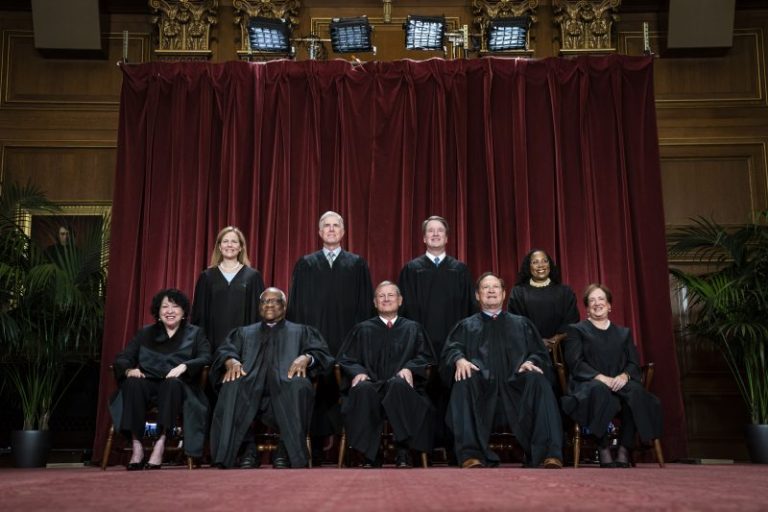It appears unlikely we’ll ever find out who leaked a draft of the Supreme Court’s opinion overturning Roe v. Wade before it was handed down last year. That’s the sum total of a report released Thursday laying out the court’s investigation into the leak.
The report states that “it is not possible to determine the identity of any individual who may have disclosed the document or how the draft opinion ended up with Politico.” The investigation will continue in some measure, but the fact that the court chose to release such an inconclusive report is telling about its lack of optimism about ever finding the culprit.
That said, even as the report laid out its lack of a broader conclusion, it seemed to arrive at a pretty significant, if narrower, one — however well considered. And indeed, its brief “statement of the court” leads with that apparent conclusion.
“The leak was no mere misguided attempt at protest,” the statement from the court reads in its second sentence. “It was a grave assault on the judicial process.”
The key word there is “protest.”
The most prevalent (and to our mind most plausible) theory about the leak is that it was the result of someone on the left who was unhappy with what the court was about to do. Congressional Republicans and Fox News hosts have gone as far as to state this possibility as more or less a fact.
But such certitude is hardly warranted, given how little we knew then about what happened, and how little we still know. And there are other plausible theories. Many on the left have wagered the leak might have come from the court’s right flank. The court had the bare minimum of five votes to overturn Roe, the main such argument goes, so maybe the draft was leaked in an effort to prevent any of the five from going wobbly and opting to side with Chief Justice John G. Roberts Jr. in delivering a narrower ruling.
Longtime NPR Supreme Court reporter Nina Totenberg at one point last spring labeled this the “leading theory” and “I think the only one that makes sense.” And recently a former antiabortion activist said he received details of an impending 2014 decision in advance from a conservative donor who had dined with Justice Samuel A. Alito and his wife. (Both Alito and the donor denied this.)
This is all speculation. But the point is that the language used in the Supreme Court’s statement doesn’t seem to allow for the latter theory. It says this was a “protest” — i.e. coming from someone unhappy about something — and doesn’t contemplate the possibility that this might have been strictly a strategic play.
The report that is included alongside the court’s statement does broach the idea that someone leaked the draft for “strategic reasons.” “Investigators also carefully evaluated whether personnel may have had reason to disclose the Court’s draft decision for strategic reasons,” reads the report from Supreme Court Marshal Gail Curley.
That’s not mutually exclusive of it also being a protest; indeed, many protests are done for strategic reasons. But the theory that this was done by someone on the right wouldn’t be compatible with it being an act of “protest.”
It’s valid to ask from there why the court chose these descriptions in its statement. It’s difficult to believe this was a willy-nilly choice of words. These are literally the nine individuals the American people have entrusted with the most responsibility to carefully parse language. And the word “protest” sits at the very top of the statement; they must have considered how it would be read. Perhaps the liberal justices, to the extent they signed off on this, think that’s really what happened. (The statement is unsigned, even by Roberts, and there is no indication of dissent. Such statements will generally be closely examined by all the justices. But we don’t know precisely how the statement came about, because the court’s operations are so opaque.)
If there’s any evidence to support that conclusion, though, it’s certainly not in the report.
The court’s statement says that it has “been unable to identify a person responsible by a preponderance of the evidence.” A preponderance of evidence is a pretty low legal standard — basically requiring something to be more likely than not. So they haven’t isolated the potential culprit even to that low standard of proof, yet they’re convinced this was a protest? They don’t even have a bona fide suspect, but they’ve settled on at least a broad motive?
To the extent the report did point to wrongdoing that the investigation had factually established, it notes that some of those interviewed said they disclosed details to their significant others.
“Some individuals admitted to investigators that they told their spouse or partner about the draft Dobbs opinion and the vote count, in violation of the Court’s confidentiality rules,” the report says.
But the report doesn’t detail who these people were or their political persuasions, including whether they might have worked for a specific justice. And it suggests none of these conversations led to anything close to concrete about the leak itself.
All of which means the court, through its opacity and its conspicuous choice of words, has arguably left the matter more shrouded in mystery than before.

